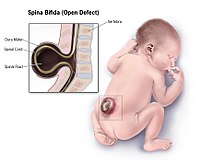
Photo from wikipedia
Spontaneous cerebrospinal fluid (CSF) leak (SCSFL) occurs in the absence of any trauma, surgery or underlying intracranial pathology. SCSFL can lead to complications such as brain abscess, meningitis, decreased intracranial… Click to show full abstract
Spontaneous cerebrospinal fluid (CSF) leak (SCSFL) occurs in the absence of any trauma, surgery or underlying intracranial pathology. SCSFL can lead to complications such as brain abscess, meningitis, decreased intracranial pressure (ICP), headache and brain herniation. We present our experience of SCSFL repair performed by a single surgeon at a tertiary centre via the endonasal endoscopic approach. All patients who underwent CSF fistula repair at the Queen Elizabeth Hospital Birmingham, between 1st January 2012 and 31st December 2019, were identified and had their case notes analysed retrospectively. We identified 33 patients who satisfied our inclusion criteria. They consisted of 27 (81.8%) female patients, ranging in age from 31 to 81 years (mean age 55.2 ± 13.2 years). Combined CT/MRI imaging was able to identify the leak in 30 patients (91%). Post-operative complications occurred in 2 patients (6.1%) with 1 patient developing meningitis (3.0%) and 1 patient experiencing epistaxis (3.0%). Overall, there was a successful primary repair in 32 (97.0%) cases. Endoscopic endonasal repair of SCSFL has rapidly grown in popularity and now become the treatment of choice, overtaking open transcranial approaches. Several studies have demonstrated success rates of between 80-94% for spontaneous leaks however not all have addressed the issue of concurrent IIH post-operatively.
Journal Title: British Journal of Surgery
Year Published: 2021
Link to full text (if available)
Share on Social Media: Sign Up to like & get
recommendations!